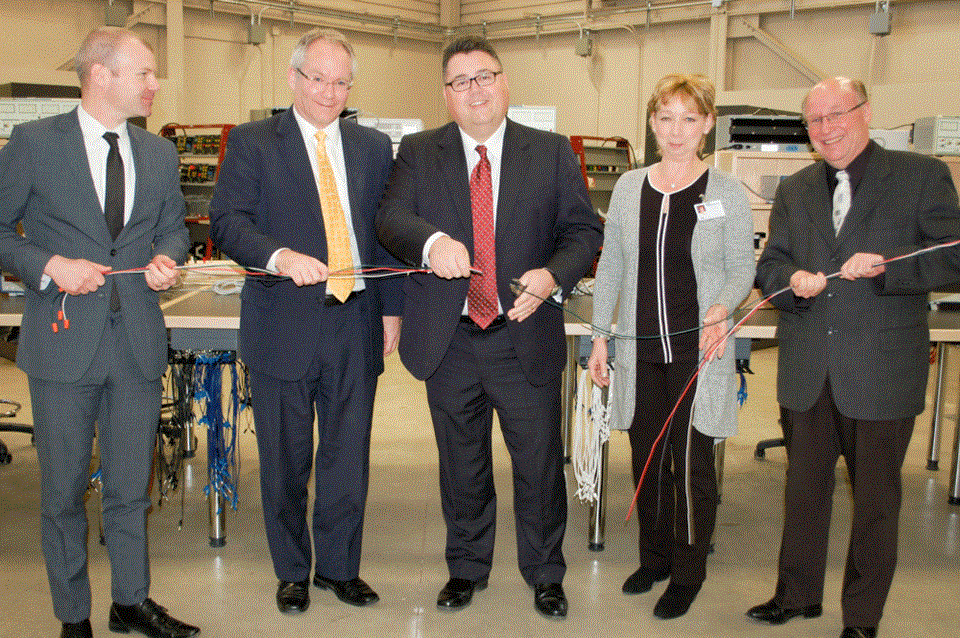It has been a classic case of identifying needs and fulfilling them in a cost-effective and least disruptive manner.
That was just one of the themes running through the late morning launching of the Level 2 construction electrician apprenticeship program at the Estevan Campus of the Southeast College on Feb. 12.
The training laboratory on the ground floor of the facility, features state of the art equipment and material thanks in large part to a $509,000 contribution to the program by the Canadian Western Economic Diversification (WD) arm of the federal government.
The event brought out a bevy of politicians as well as agency and college representatives to mark the occasion that included the cutting of several strands of electrical cords.
The opening acknowledged over a year and a half of collaboration with the Saskatchewan Apprenticeship and Trade Certification Commission (SATCC) and Saskatchewan Polytehnic for the research, equipment purchases and lab construction. The new lab will allow area electrical apprentices, and others from across the province, to take Level 2 apprenticeship training with the industry’s state of the art equipment in Estevan, said the Southeast College’s president and CEO Dion McGrath.
“In consultation with our community and educational partners, we recognized an opportunity to deliver the high-demand trade in our region,” said McGrath.
That fact was bolstered by Jeff Ritter, CEO of apprenticeship and trade certification for the province, who noted between 60 and 70 applicants had expressed interest in the program and qualified for the training, with 12 being accepted for the program. There is also a Level 1 entrance apprenticeship course offered at the Estevan campus.
“It’s a big year for the college,” said McGrath, a point that was echoed by the board of governors’ vice-president, Janice Giroux, who added that when the opportunity arose to offer the course in the southeast with the backing of the Saskatchewan Polytechnic campuses in Prince Albert and Moose Jaw, it was immediately given a green light.
With the financial backing of WD, represented by Matt Deutscher, manager of trade and development in their Saskatoon headquarters, the project moved forward with lead instructor Darcy Wright signed on to deliver the necessary training for the first wave of students.
Jim Martin, program leader for electrician training with Sask. Polytechnic, said the introduction and continuation of training has been carried out seamlessly.
Wright said the Southeast College was very responsive when it came to procuring materials required for the program, with the Estevan lab now carrying the most recent equipment available, which Martin said was a big factor as the construction electricians get into the world of AC and DC electrical motors and construction requirements.
“By having these regional electricians being able to get their training locally is the least disruptive and cost effective way to get them ready,” said Ritter when speaking with the Mercury just prior to the cord-cutting ceremony.
The fact the program is being delivered under budget is a plus.
“With 8,700 construction workers in Saskatchewan entering retirement within the next few years, that represents 20 per cent of our construction workforce that will have to be replaced,” Ritter said. “There are electricians lined up clamouring for this type of training, so it’s a matter of complying with the demand, the economic cycles and the demographics that deal with an aging workforce.”
Weyburn-Big Muddy MLA Dustin Duncan was on hand to represent the provincial government, stating that “it is shaping up to be a great year for the college and for this region with over $23 million being spent on apprenticeship training alone. This is a solid investment in Saskatchewan’s future” he said.
“It’s demand-side training,” said Ritter in explaining the need for programs such as the Level 2 certification course to be flexible and ready to meet demands.
He said 85 per cent of the training at this level is done on the job with an assigned mentor/trainer working with the apprentices and then the laboratory work takes up the rest of the schedule and hours, with about eight weeks of “theoretical underpinnings,” and then it’s back to monitored training at the worksites. It’s a formula that has worked well over the years since it combines practical with theoretical and laboratory work for the discovery elements of the trade.
Souris-Moose Mountain MP Dr. Robert Kitchen said this “in-and-out” training example is one of the proven best with excellent instruction guaranteed in the labs and on the job.
“And I like that WD motto we see here today,” he noted, pointing to a backdrop poster that declared The West Means Business.
Kitchen said the program meant more strength for the local economy while promoting lifelong learning.
McGrath noted the Estevan lab represented the first Level 2 training offered outside of the centres of Moose Jaw and Prince Albert. He said when potential partnerships were identified with Saskatchewan Polytechnic, WD, and the provincial government, it then became a matter of putting a business plan in front of them a development that took nearly two years, but eventually came together smoothly. “We can now collaborate in the future to see if there are other learn where you live opportunities,” McGrath said.
The college offers a full range of scholarships and bursaries for deserving students with over 5,000 graduates from their courses annually. It is estimated the college contributes about $19 million to the region’s gross domestic product through its flexible and innovative programming, such as that which was on display that day.




